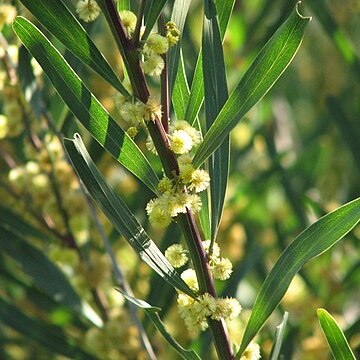Unarmed shrub to c. 5 m high. Branchlets angular, with yellowish resinous ribs. Phyllodes linear-spathulate, gradually tapered to the base, apex abruptly contracted, obtuse, apiculate; main vein and margins prominent, resinous, sometimes a faint second longitudinal nerve present for a short distance on the adaxial side, and conspicuously, closely reticulately penniveined, 7.5-10.5 by 0.6-0.9 (-1.7) cm, (6-)9—13 times as long as wide, gland prominent, close to the base. Flowering heads composed of c. 25 flowers in clusters (condensed racemes with very short rachis) of 2-7 in the axils of the phyllodes. Pod linear, ± straight, slightly glutinous, with thickened margins, to 7 by c. 2.5 cm. Seeds longitudinal, 3.5 by 1.5 mm; pleurogram large, open; funicle intricately folded, forming an aril half as long as the seed below the seed.
It is an evergreen tree. It grows to 4 m high and spreads to 4 m across. The stem is erect and stiff. It has a spreading crown. The branches are angular and point upwards. The leaves (phyllodes) are dull green. They are 4-12 cm long by 0.3-0.8 cm wide and thick. The tip of the leaf can be blunt or with a small sharp point. The leaf normally has one prominent vein and fine side veins. The leaf is narrowed towards the base. There is also a gland near the base. The flowers are deep yellow balls about 0.5 cm across. They are in small clusters in the leaf axils. The flower heads have 50-60 small flowers. The pods are straight and flat. They are about 7 cm long and light brown. They are 0.4-1 cm wide and not constricted between the seeds.


